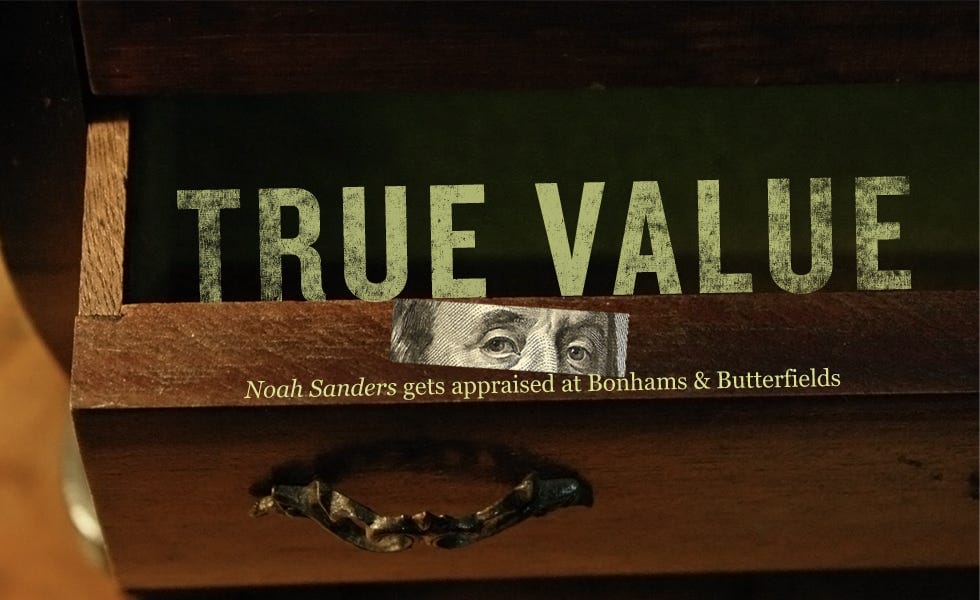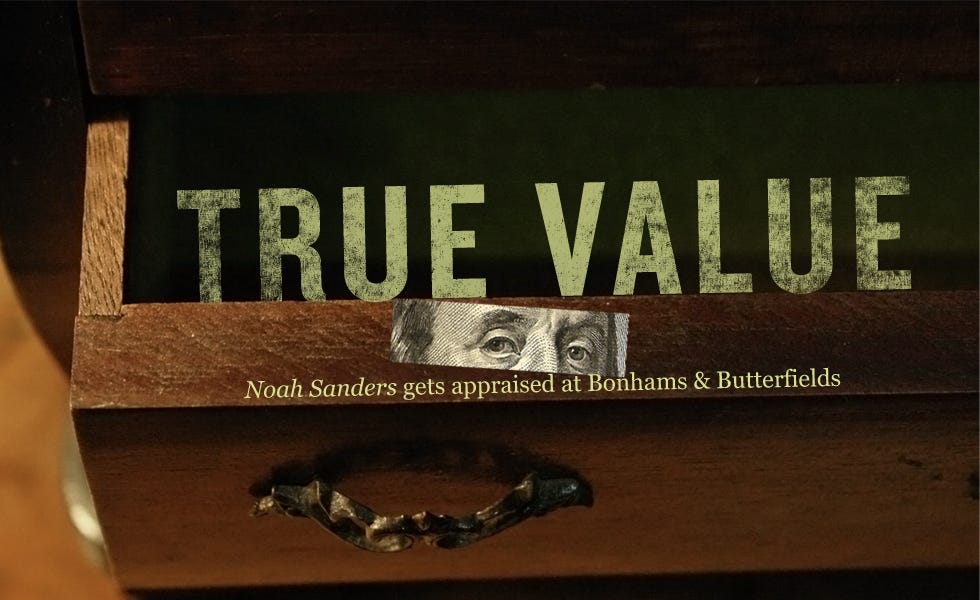
By Noah Sanders
I’m the co-owner of a fledgling estate sale company called Old Hat that works with the estates of the recently deceased. On a daily basis, I deal a lot with antiques and assessing their value (both estimated and actual). Over the brief amount of time I’ve dabbled in the estate sale business, I’ve not only accrued a good amount of vintage collectibles, but I’ve garnered a mighty fine interest in the old and antique. Recently, I’ve developed a burning curiosity to know how much might these goods I’ve accumulated are worth. Hundreds? Millions? The cost of the paper they’re printed on?
A San Francisco emporium specializing in fine art, antiques, and decorative objects, Bonhams & Butterfields offers a monthly free appraisal day. For three brief hours on the first Wednesday of every month starry-eyed antique enthusiasts can bring a family heirloom or the dusty still life they think might bean original Rembrandt to the cadre of antique experts employed by one of the world’s largest auction houses.
A little bit broke and massively curious about what I might have on my hands, I grab my signed copy of Anaïs Nin’s Introduction to Henry Miller’s Tropic of Cancer and a slightly worn 1935 Snow White board game and head on down to the antique circus.

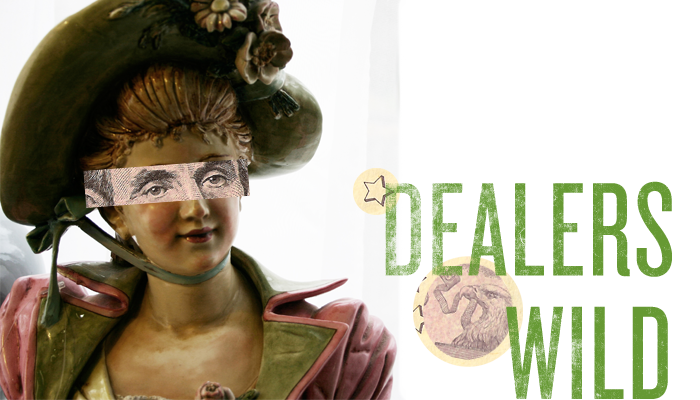
It’s 8:30 a.m. I’ve arrived half an hour early to the gray concrete slab that is Bonhams & Butterfields’ Potrero Hill gallery and I’m already late. Eager antique lovers have been here since 7:30, slurping down cheap coffee and holding down their spot in the quickly growing line. After only five minutes of being here, 20 or more people have queued up behind me, their arms weighed down by paintings and prints and brutally heavy statues.
From what I know of dealers and those heavily invested in buying, selling, and auctioning antiques, I figured that the atmosphere of one of these preshow lineups would be, well, tense. When the doors are heaved open at estate sales I’ve seen dealers throw actual elbows to get inside first.
A bookseller I know regaled me with a tale of coming to blows with another dealer while they scavenged through a dumpster for antique literature. Today, though, the motley line stretching its way down San Bruno Avenue is surprisingly tame. Several groups of people stand around in clumps and have friendly discussions about what they’ve brought or gossip about a ridiculous deal some other antique hound stumbled across at a poorly attended auction. Instead of the grim silence and low-muttered insults I expected, people are talking and meeting each other.
At 9:20, an attractive older women with silver hair and the type of glasses dangling from her neck you imagine on a librarian from 1954, steps out of the building and breaks down what’s about to happen.
We’re to enter quietly and orderly, we’re to show our items to the volunteers at the front, and we’re to be given a card that instructs which line to wait in for our appraisal. Moments later, the chatter is hushed, the amiable atmosphere is suddenly chilled. With the opening of the doors just moments away, the people in line grow tense and I swear I can suddenly see money signs and question marks float above the crowd. Feet shuffle, and a hacking cough from the back of the line sounds harsh and dangerous in the sudden quiet. I clutch my antiques with new, sweaty-palmed purpose.
And then the doors open.
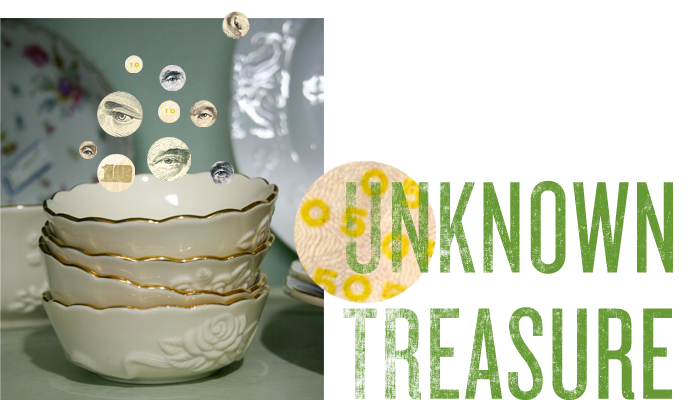
I’m expecting a small stampede from the crush of people now lumbering toward the door, but am pleasantly surprised that the iron-fisted workers who help run Bonhams’ monthly to-dos, keep the chaos to a bare minimum. Antiques in hand, we all slowly shuffle toward the now gaping glass doors of the Bonhams headquarters.
At the front of the line the silver-haired guide quickly eyes my items. “Books for the pamphlet, Toys and Games for the Snow White premium. Head in there and wait in line. Have a nice day.” I smile and awkwardly thank her, turning toward the din that’s loudly leaking from the auction room floor.
Inside the main auction hall I finally find the madhouse I’m expecting. Imagine Antiques Roadshow but without the corralling power of television’s mighty cameras.
It’s loud in here, a sort of weighty clatter of frantic customers mixed with the soothing, knowing tones of the experts. Fifty or 60 chairs have been set up and are now full with eager enthusiasts and their antiques. Lines of people zigzag in a rough square around the space. In the far corner two brightly smiling women sit at the Consignment Contracts table, the sort of holy grail of appraisal day. If you’ve brought the right stuff, this is where you’ll end up, one step closer to untold riches.
A curly haired septuagenarian with a vaguely Eastern European accent asks what I’m looking for and then takes down my name, number, and email address (asking me to spell out “Gmail”) and points me toward an empty table. “Wait here, the appraiser
is late.”
I sit and observe the others in the room with me. A woman, teeth missing and the odor of cigarettes almost visible on her clothes, holds two three-foot horns, each inscribed with Japanese characters. In front of her, two women, clearly friends, smile and chatter, excited just to be here, surrounded by antiques. I hear a man ask, “Where do I go to get my 1930s zeppelin menus looked at?” A short couple clench a pair of wooden horse puppets to their chest. Asian art, prints, photography, toys, games — it’s all here.
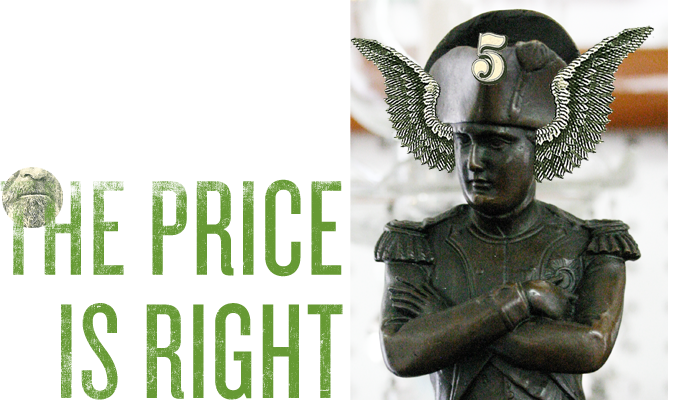

After five minutes of waiting, a tall, snappily dressed gentleman sits down, introduces himself as Ivan and asks to see my Anais Nin. I expect appraisers and experts, as a rule, to be unfriendly. Intelligence is a great and heavy burden and so many times in the field of antiques I’ve felt its cold hand brush me aside. Ivan is the antithesis of this. He holds the Anaïs Nin pamphlet with reverence, gently turning it over in his hands, lightly fingering the scrawled inscription inside. With a deep voice, he explains that to fully assess the piece he’d need to send it to his signature expert in Los Angeles, but even without that, he doesn’t think that it’s worth enough to be auctioned at Bonhams. Even though I’m here solely for the experience, the pamphlet’s lack of worth drops my stomach a bit.
“So it’s not worth anything?” I ask.
“Oh no, oh no. It’s a great little piece, in solid condition. I’d say it’s probably worth $300 if sold to the right person. We’re only interested if it is worth 500 or more.” I freeze. Three hundred dollars? That’s two-thirds of my rent, a fancy dinner on the town for me and Alex, one-third of a new computer — I almost want to hug him.
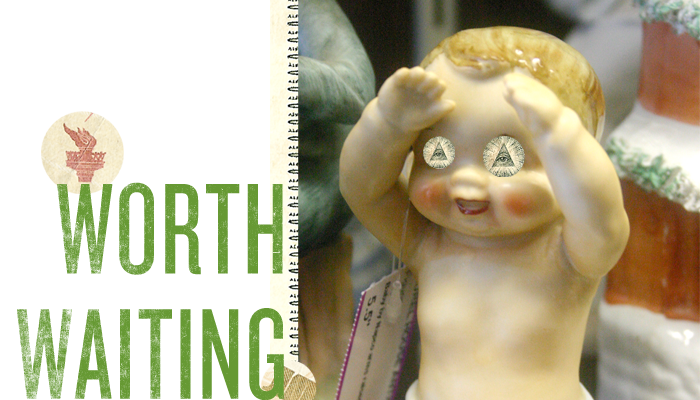
Next up, Toys and Games. I sign up on the list and sit in an uncomfortable chair. The longest line seems to be for Paintings; a mass of people sit and wait, clinging to artwork I’d imagine my mother would purchase at a garage sale. A woman getting her oil painting of a lighthouse assessed is red-faced and unhappy; she peppers the appraiser with disbelieving questions about his verdict. Behind me, I overhear a man and a woman, weighed down with bags of rolled prints and lamps, quietly discuss their strategy. Finally my name is called and I head toward Toys and Games.
Unfortunately, the appraiser is also running late today. Caitlin, the business manager for the department takes pictures of my Snow White game (a premium sent out by Johnson and Johnson in the 1930s) to show to the appraiser when he comes in. While snapping photos, Caitlin gives me her personal assessment: It’s a great piece and she couldn’t imagine it not being worth something. She says I’ll get the official appraisal by the end of the afternoon. (As of the writing of this piece, no one from Bonham and Butterfields has contacted me about the possible worth of my antique board game. I can only assume that Bonhams is a busy place, and on occasion one man’s quest to discover the worth of his toy, might just disappear into the vaults.)
By the time I leave Toys and Games there are still two hours left in the appraisal day, but my time here is coming to a close. A well of financial excitement burbles in me. My book is worth $300 and my Snow White game a possible winner. I sit down, the thrumming line of antique-bearing hopefuls continuing to stream in. Behind me two men discuss their friend, a prison guard who knows that his police station has a valuable painting in lockup. I follow the edge of my Anaïs Nin pamphlet with my finger, my mind clear, the noise of the room steadily filling my ears.

Bonhams & Butterfields’ free appraisal day happens the first Wednesday of every month, from 9:30 a.m.-12:30 p.m.. Arrive early with a hot cup of coffee in tow. The Bonhams & Butterfields website also has a schedule of upcoming auctions, a great way to see an amazing array of antiques for free.
Design: Stacy Stanfield



